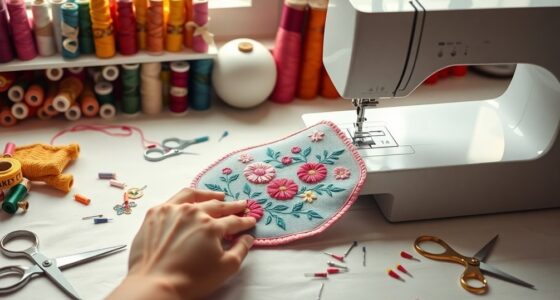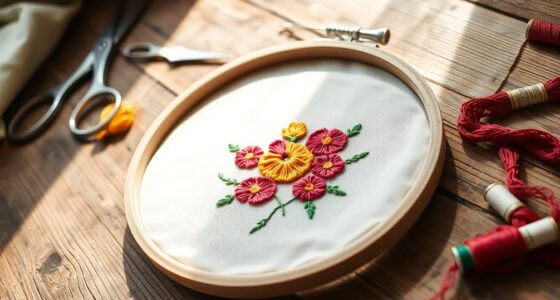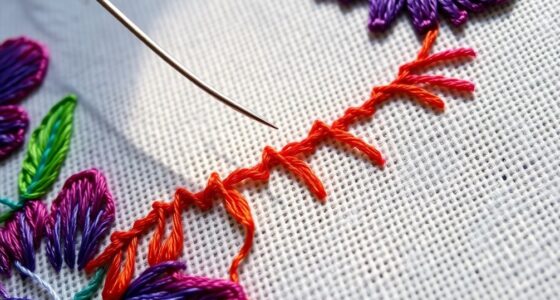The time embroidery takes varies greatly based on the design complexity, your skill level, and whether you're using a machine or hand stitching. Simple designs can often be finished in just a few hours, while intricate patterns might take days or even weeks. Experienced stitchers work faster than beginners, and planning can help you manage your time better. To uncover more insights into enhancing your embroidery efficiency and project fulfillment, keep exploring this topic further.
Key Takeaways
- The time required for embroidery depends on the complexity and size of the design, ranging from hours to weeks.
- Simple designs can be completed in a few hours, while intricate patterns may take several days or weeks, especially for beginners.
- Machine embroidery is generally faster than hand embroidery, with simple projects taking minutes and more complex ones several hours.
- Skill level significantly influences speed; experienced stitchers can complete projects more quickly than novices.
- Planning and daily practice can enhance efficiency and reduce the overall time needed for project completion.
Understanding the Time Commitment in Embroidery
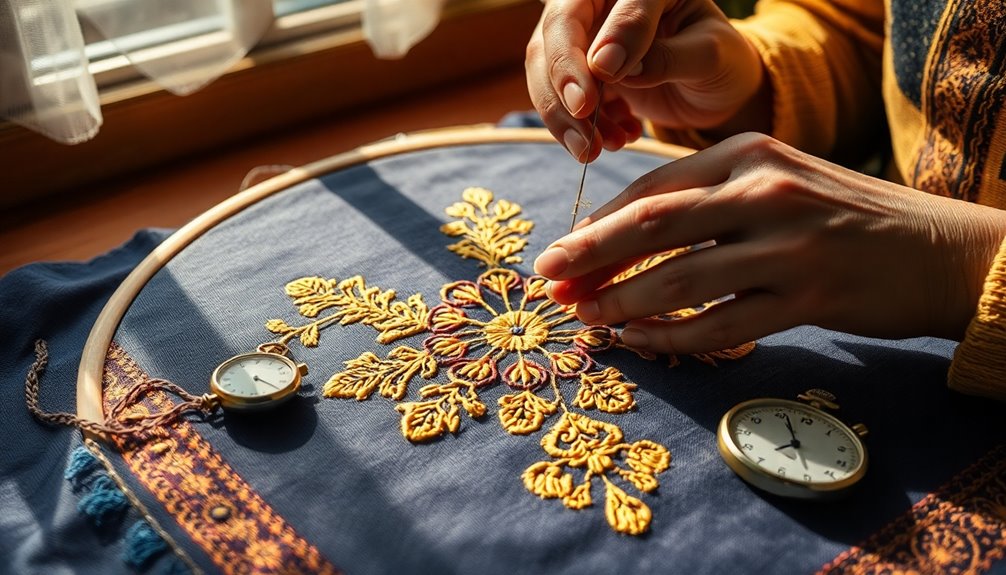
When you're diving into embroidery, it's essential to recognize that the time you'll invest varies widely depending on several factors.
The time it takes to complete your projects largely hinges on the complexity of the designs and patterns you choose. Simple designs can be finished in just a few hours, while intricate patterns may demand several days or even weeks.
If you're using a machine, you could whip up a hat in about 5 minutes, but garments like t-shirts might take 5-6 hours. Hand embroidery typically consumes more time, especially for beginners who might need breaks.
Additionally, larger projects will naturally require more time, making it wise to start with simpler, smaller tasks to build your skills.
Factors Influencing Embroidery Duration
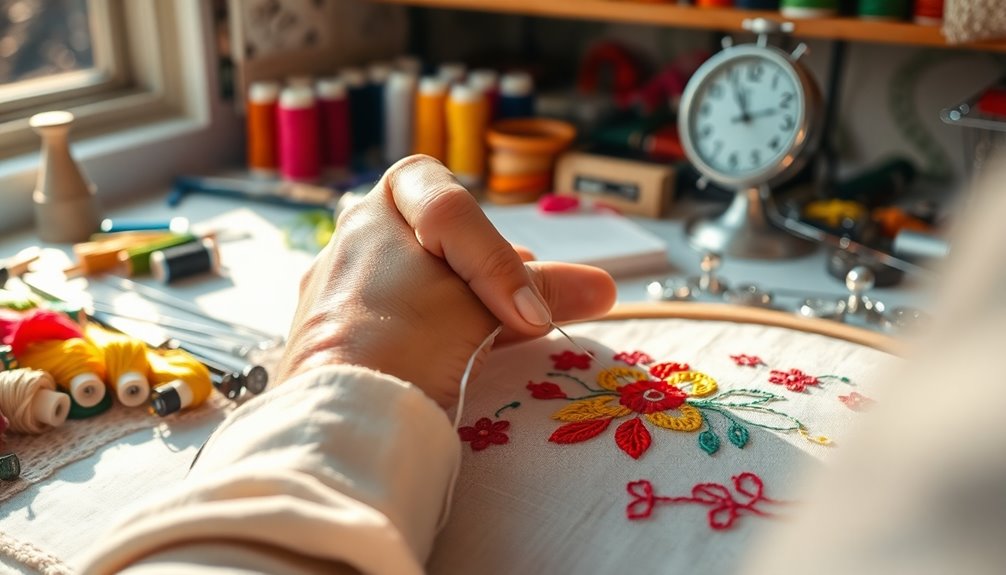
Several factors influence how long your embroidery project will take, starting with the complexity of the design. Simple designs may only require a few hours, while intricate ones can take days or weeks to finish.
Consider these additional factors:
- Size of the project: Larger projects naturally demand more time.
- Skill level: Experienced embroiderers usually work faster than beginners, who may need more breaks.
- Method of embroidery: Machine embroidery is quicker than hand embroidery, often taking just minutes to hours.
- Daily time commitment: Consistent work, even in small increments, can speed up your project's completion.
Understanding these elements can help you better estimate the time needed for your embroidery project.
Time Estimates for Hand Embroidery
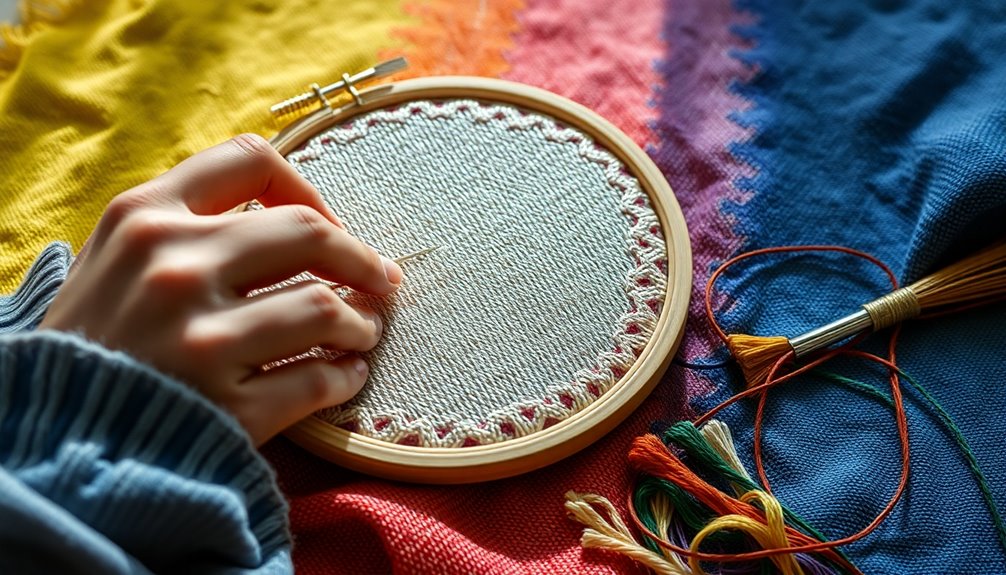
When you're planning a hand embroidery project, the complexity of the design plays a huge role in how long it'll take you to finish.
Your skill level also makes a difference; as you gain experience, you'll likely find you can complete projects more quickly.
Design Complexity Impact
As you explore the world of hand embroidery, you'll quickly notice that the complexity of your design heavily influences the time it takes to complete your project.
Here's how different factors impact your time investment:
- Simple designs (basic shapes or single-color patterns) can be finished in just a few hours.
- Intricate designs (multiple colors and detailed stitching) might take several days or weeks.
- Stitch density plays a significant role; denser designs require more time.
- Skill level matters too; beginners often take longer on complex designs due to the learning curve.
Skill Level Variability
While your skill level can greatly influence the time it takes to complete embroidery projects, the impact is especially pronounced when comparing beginners to experienced stitchers. Beginners may take several hours to finish simple designs, while intricate ones can stretch to days or weeks. In contrast, experienced stitchers can typically complete simple projects in 1-3 hours, with more complex patterns still taking several days. This skill level variability not only affects the amount of time required but also the accuracy of estimated completion times.
| Skill Level | Estimated Time to Complete |
|---|---|
| Beginners | 3+ hours (simple) |
| Days to weeks (intricate) | |
| Experienced | 1-3 hours (simple) |
| Several days (intricate) |
Time Management Strategies
Understanding how long embroidery takes can help you plan better and manage your time effectively.
Here are some time management strategies to keep your embroidery projects on track:
- Set aside consistent daily time slots, even if it's just 15-30 minutes.
- Start with straightforward designs and gradually increase complexity as your skills improve.
- Factor in extra time for potential mistakes, especially if you're a beginner.
- Take regular breaks during your sessions to prevent fatigue and enhance productivity.
Time Estimates for Machine Embroidery

When it comes to machine embroidery, the time it takes can vary widely based on the project. For instance, completing a logo typically takes about 2 to 3 hours, while a garment like a t-shirt may require 5 to 6 hours. If you're working on a single embroidered patch, expect around 6 to 7 hours depending on design complexity. Simple designs can be finished in just minutes, while intricate ones will take longer.
| Project Type | Estimated Time |
|---|---|
| Logo | 2 to 3 hours |
| T-shirt | 5 to 6 hours |
| Single Patch | 6 to 7 hours |
The Impact of Design Complexity on Time
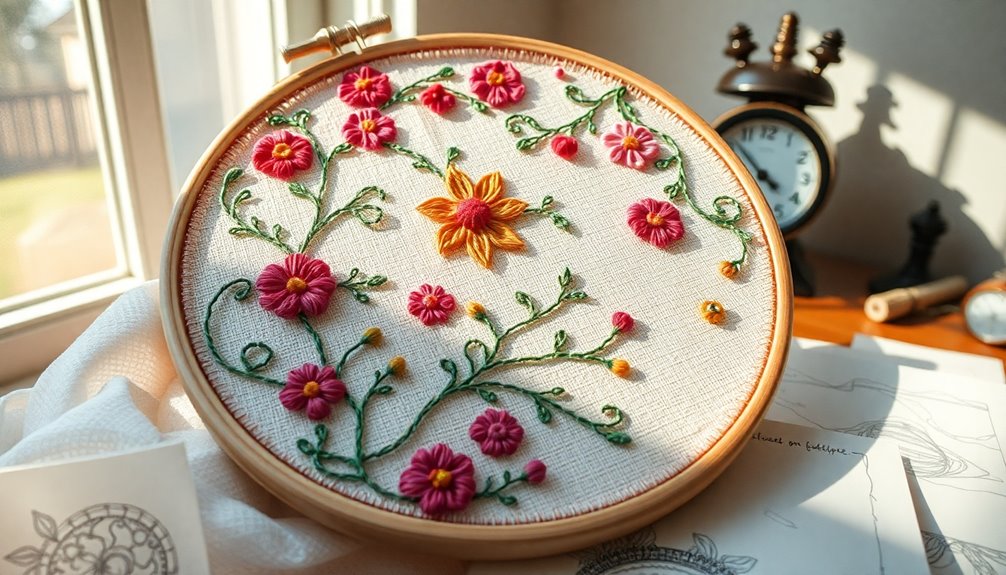
When you tackle embroidery, the complexity of your design can considerably affect how long it takes to finish.
Simple designs are often quick and efficient, while intricate patterns can pose challenges that extend your timeline.
Your skill level also plays an essential role; starting with simpler projects can help you build the confidence needed for more complex embroidery.
Simple Designs Efficiency
While simple embroidery designs can be a great choice for quick projects, their efficiency largely depends on the design's complexity.
When you opt for simple designs, you can expect to enjoy several benefits:
- Fewer colors: This means less time spent changing threads.
- Limited stitch count: A lower stitch count greatly reduces the time it takes to complete.
- Ease for beginners: Simple designs help build confidence and skill without overwhelming you.
- Quick turnaround: Many simple designs can be finished in just a few hours, or even minutes with machine embroidery.
Intricate Designs Challenges
Although intricate designs can showcase incredible artistry, they also come with significant challenges that can extend your embroidery timeline. When you tackle these detailed patterns, you might find that they take longer to complete due to the numerous thread changes and stitch types involved.
Each added color and detail increases the complexity, requiring more time and potentially slower machine speeds to maintain precision. If you're a beginner, you may face even more delays as you navigate the learning curve associated with advanced techniques.
To keep your project on track, consider simplifying intricate designs, allowing you to achieve visually appealing results without the extensive time commitment. Remember, the beauty of your work doesn't always require complexity.
Skill Level Influence
Intricate designs can be overwhelming, especially for beginners who might struggle with the various techniques and details involved.
Your skill level influence plays a significant role in how long a project takes.
Consider these factors:
- Design Complexity: Simple designs take a few hours, while intricate ones can span days.
- Color and Stitch Count: More colors mean additional thread changes, increasing time.
- Technique Familiarity: Beginners may face frustration, slowing progress.
- Embroidery Method: Using an embroidery machine speeds up simple projects but intricate designs still take hours.
Additionally, the use of crochet tools can aid in creating detailed patterns more efficiently, which may help reduce the time spent on complex embroidery projects.
Skill Level and Its Effect on Completion Time
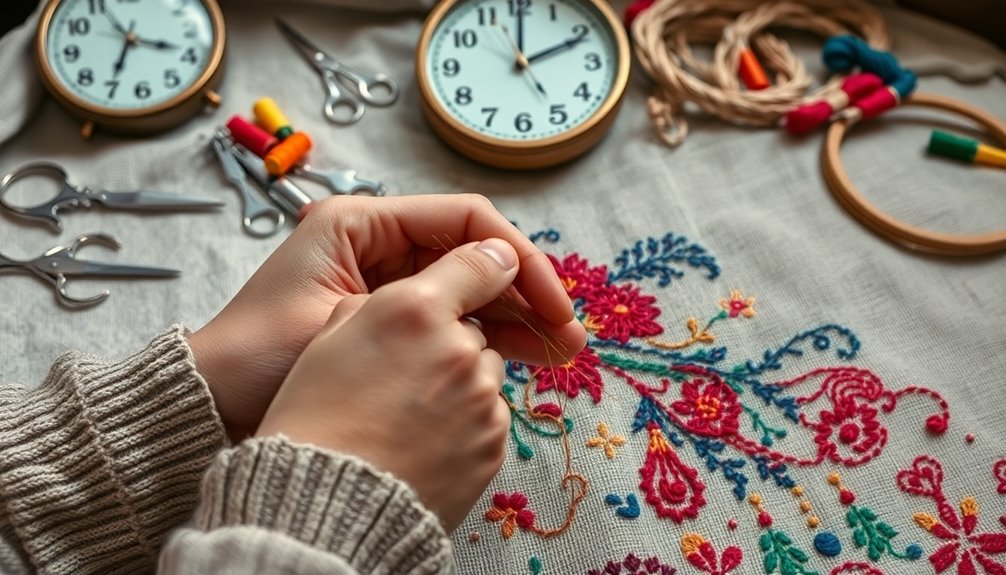
As you immerse yourself in embroidery, your skill level plays an essential role in determining how long a project takes. Beginners often take longer to complete tasks due to inexperience, which leads to frequent breaks and mistakes.
In contrast, experienced embroiderers can estimate completion times accurately and work more efficiently. This efficiency allows seasoned practitioners to finish intricate designs in a fraction of the time it takes novices.
Additionally, as you practice and expose yourself to various stitching techniques, you'll gain confidence and speed, enhancing your overall efficiency.
Planning and Scheduling Your Embroidery Projects
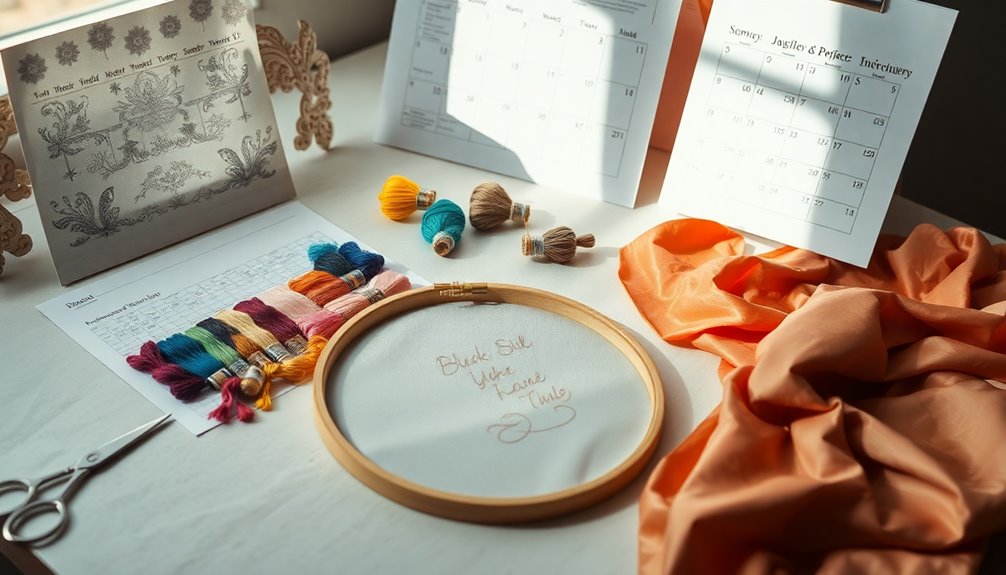
Once you’ve honed your skills, planning and scheduling your embroidery projects becomes key to achieving your desired outcomes. Once you’ve honed your skills, planning and scheduling your embroidery projects becomes key to achieving your desired outcomes. Carefully organizing your workflow allows you to set realistic deadlines and ensures that each piece receives the attention it deserves. For those interested in expanding their repertoire, learning how to create embroidery patches can be an exciting venture that adds a new dimension to your craft. By breaking down the process into manageable steps, you can seamlessly incorporate this technique into your project schedule.
Start by considering the complexity of your design. Simple designs typically take a few hours, while intricate ones may require days or weeks.
To effectively manage your time, keep these points in mind:
- Establish a realistic timeline: 1-2 weeks for simple designs, 3-4 weeks for complex ones.
- Order materials early to avoid delays.
- Factor in additional time for revisions or adjustments.
- Commit to daily progress, even in small increments.
Creating a structured project schedule that accommodates size and skill level will enhance organization and lead to more successful results in your embroidery endeavors.
Tips for Improving Embroidery Efficiency
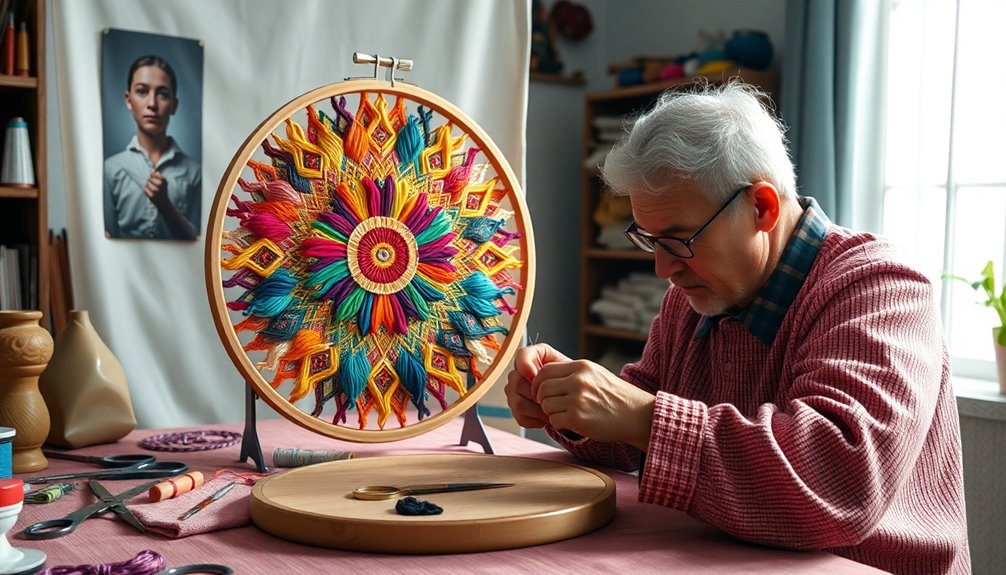
Improving your embroidery efficiency can save you time and enhance your overall experience, especially when you focus on simpler designs. Complex patterns can take days to finish, while straightforward designs can be completed in just a few hours. When using a machine, you can considerably cut down project time, finishing simple designs in mere minutes.
To make your process smoother, organize your workspace by gathering threads, needles, and fabric beforehand, reducing interruptions.
Regularly maintain your machine by checking tension settings and verifying proper threading to avoid thread bunching or shredding.
Finally, set aside dedicated time each day for embroidery practice to enhance your skills and guarantee consistent progress, speeding up your completion times.
The Joy of Crafting: Embracing the Process
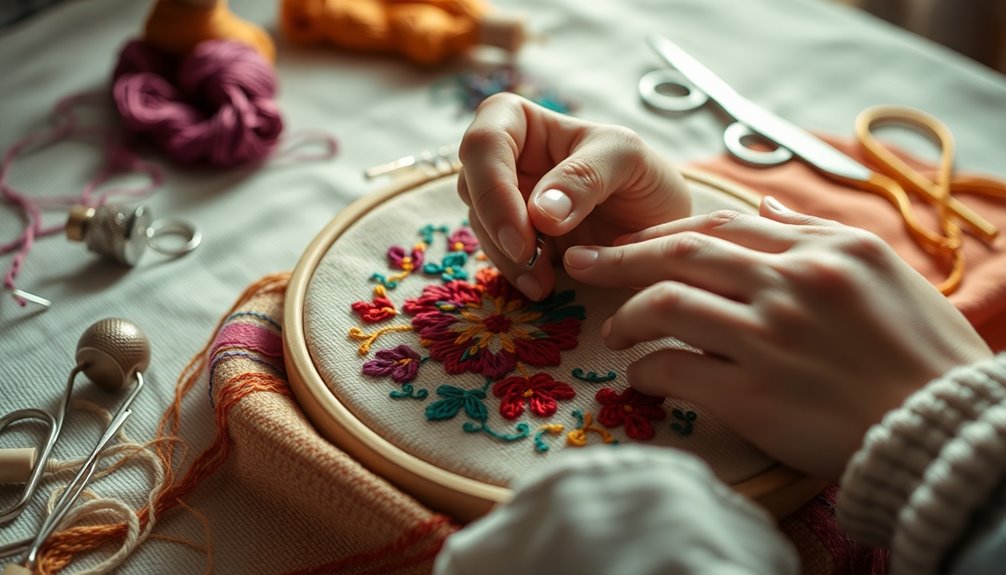
Embroidery offers a unique sense of fulfillment that goes beyond just creating beautiful designs. When you embrace this craft, you'll discover it's a relaxing hobby that requires time but rewards you richly. The joy lies not only in the finished piece but in the journey.
- It greatly reduces stress and promotes mental well-being.
- You can release your creativity and personalize your projects.
- Engaging with others fosters a sense of community among crafters.
- The meticulous nature of embroidery cultivates patience and attention to detail.
As you immerse yourself in each stitch, you'll find that every completed piece reflects your personal effort and artistry, leaving you with a fulfilling sense of accomplishment.
Frequently Asked Questions
How Long Does Embroidery Usually Take?
Embroidery usually takes anywhere from a few hours to several weeks, depending on the design's complexity.
Simple designs can be completed in 1-2 weeks, while intricate ones may stretch to 3-4 weeks.
If you're using a machine, garments like t-shirts typically take 5-6 hours, whereas hats can be done in about 5 minutes for 3500 stitches.
Your skill level also impacts time; experienced embroiderers work faster than beginners.
How Much Time Does It Take to Learn Embroidery?
Wondering how long it'll take you to learn embroidery? It really depends on your previous sewing experience.
If you're a beginner, you might need several weeks to grasp the basics. Self-taught learners often progress slower than those in structured classes, so consider that.
Mastering fundamental stitches typically takes a few hours to several days. With regular practice and the right resources, you'll find yourself improving steadily, but patience is key!
What Is the Turnaround Time for Embroidery?
The turnaround time for embroidery varies based on the design's complexity and the number of items you're having embroidered.
For simple designs, expect about 1 to 2 weeks, while complex ones may take 3 to 4 weeks.
If you've got a large order or need it by a certain date, planning ahead is key.
Always factor in extra time for revisions, so you're not rushed when you need your finished products.
How Long Does It Take to Make an Embroidered Patch?
You'd think making an embroidered patch is a quick task, right?
Well, it typically takes you about 5 to 7 hours with a machine, depending on how intricate your design is.
Hand-stitching, on the other hand, can eat up an entire day!
Keep in mind that simpler designs finish faster, while complex ones could stretch over several days.
Conclusion
In the world of embroidery, patience pays off, and practice makes perfect. Whether you're stitching by hand or using a machine, embracing the process, enjoying the creativity, and celebrating your progress can transform your experience. Remember, each project teaches you something new; each stitch adds to your skill. So, take your time, enjoy the journey, and let your passion for embroidery flourish. With every thread, you're not just crafting; you're creating memories.


